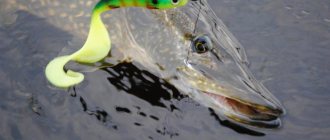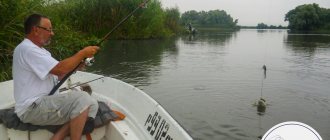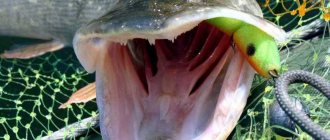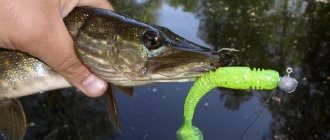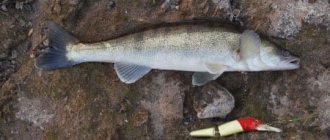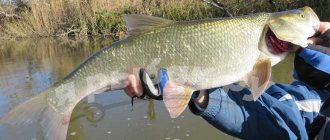Date: March 22, 2021 | 453
Taimen is one of the largest salmon fish. Most representatives of this family are migratory fish that live in the sea and enter rivers only to spawn. But this fish, with the exception of the Sakhalin taimen, is sedentary and constantly lives in the fresh water of Siberian and Far Eastern rivers. The fishermen are lucky that the most powerful and interesting, as a trophy, species of salmon lives in inland waters. So it is possible to localize the places where it is caught much easier than in the open sea. In this review I will tell you how to successfully catch taimen in rivers using a spinning rod. How to look for potential sites for large taimen. What gear and bait to use for taimen fishing.
The fish grows to impressive sizes. It can be more than one and a half meters long and weigh more than 60 kg. Remote habitats, where you can’t always get to a helicopter, give hope that the largest taimen will never be discovered and caught. Let his growth limits remain a mystery for as long as possible. In a good way, individuals weighing up to 6 kg are considered fry. Normal size that you can catch without shame: 10 – 20 kg. Pound fish are still not uncommon. Meeting a specimen over 25 kg is a great success.
It is possible that it was the large size and desirability of the catch that played a cruel joke on this salmon. The population is declining; taimen is included in the Red Book. Although its catch is only limited in some specific regions and rivers, it is an alarming bell. So, having caught a large specimen, try to suppress your greed and let it go. The more common salmon fish is also perfect for fish soup and roasts. For example, lenok, which is found in the same rivers and bites much more often. It is enough to carefully hold taimen in your hands, photograph, weigh and quickly release. Combined with the thrill of fighting a river giant, this should be enough. Be conscious.
After the environmental disclaimer, it's time to talk about how to catch such coveted prey.
Habitats
Taimen lives in fast, clean rivers. The range extends from the Urals, tributaries of the Kama and Pechora, to the easternmost borders. Accordingly, all of Siberia and the Far East are the regions where you should look for trophy taimen. It is present in the reservoirs of Mongolia and northern China.
The fish tries to stick to mountain rivers, areas with rapid currents and good oxygen conditions. It descends into the lowland lower reaches relatively rarely. But in typical mountain rivers, it is the middle reaches and lower reaches that are the most promising for searching for large taimen in the summer and autumn. Only in the spring, during spawning, fish migrate closer to the upper reaches. There, already on the way back to familiar areas, you can catch good specimens in completely atypical places. It seems that the stream is so small that a pound of taimen can be placed across it, and it will completely block the flow. Nevertheless, captures do occur in such places.
The very character of this fish speaks of its love for fast flowing water, rough rocky ridges, and riffles. Such traction is observed in calm, flat areas. However, on mountain rivers taimen prefers calmer places. Avoids too fast runs. Only small fish occasionally go out onto shallow rifts and wait for prey there, hiding behind rocks. Large taimen must be tracked in places with depth and slow flow, at the border of streams with different flow speeds. It often stands in niches, in snags, and at bends in the riverbed. If they catch a riffle, then enter and exit it, drain.
Taimen is also found in flowing lakes that are formed along the river. This is not entirely typical, but there have been documented cases of encountering very serious specimens in precisely such places. The fishermen were heading to the lakes for pike, but they saw exits and candles of seasoned taimen.
What kind of fish is taimen?
The genus-forming taxa is the Siberian or common taimen (Hucho taimen), which is also known by the common nicknames “krasulya”, “laziness”, “talmen”. It is characterized by the largest dimensions among all salmon and the complete absence of the hypoosmotic mechanism necessary for a safe stay at sea. In addition to the ordinary one, experts distinguish Korean (Ishikawae), Sichuan (Bleekeri) and Mityagin forms. Another famous representative of the genus is the Danube salmon (Hucho hucho).
The species is one of the largest freshwater predators and, under optimal conditions, can live for more than 60 years. In standard catches, young 6-7 year old individuals (55-70 cm) weighing 3.5-5 kg prevail. Adult fish grow faster; meter-long ten-year-olds have a mass of 12 kg. At 20 years of age, the length of the predator is 120-125 cm (25-30 kg). But these figures are far from the maximum - the largest taimen weighed 105 kg with a height of 210 cm (1943, Kotui River, Krasnoyarsk Territory).
Appearance description
The slender and elongated shape of the body has much in common with the structure of trout and has ideal streamlining parameters that contribute to rapid movement in the water. Other features of the appearance of taimen include:
- fins shifted towards the tail;
- large flattened head;
- small scales (140-150 in the lateral line);
- a huge terminal mouth with sharp teeth curved inward (two rows);
- 11-13 gill rakers;
- dark gray (dorsal), light ash (ventral, pectoral) and red (anal, caudal) fins.
To learn more:
Gudgeon: description of fish, habits and methods of fishing
The permanent color of the Krasula is represented by a greenish or brownish ridge and silvery sides with black spots. During spawning, the body turns copper, orange or red. Immature young animals are characterized by the presence of dark transverse stripes.
Where is the taimen fish found?
In Russia, the main range is represented by rivers, tributaries and cold-water lakes of Central, Western, Eastern Siberia and the basins of the Laptev, Okhotsk, Japanese and Kara seas. Taimen lives in the Lena, Yenisei, Angara, and Oka. It is found in the Urals (Kama, Pechora), Khakassia (Abakan), Altai Territory (Biya, Katun), in the Far East and Transbaikalia (Amur, Tunguska, Yana, Shilka, Vitim, Onon). Krasulya does not bypass Sakhalin (Langry, Bolshoy Chingai, Pogibi, Noyida), it is found in the rivers of the Primorsky Territory that flow into the marginal waters of the Pacific Ocean (Margaritovka, Milogradovka, Avvakumovka).
Fishing tactics
When catching taimen, there are two main tactics. This is either walking fishing on some limited section of the river, to which the fisherman reached by car or helicopter, or rafting (ascent) along the river.
Mountain rivers are often difficult to access. So walking fishing has very limited use. Here they either head to holes previously explored during rafting, or simply stop for the night and simultaneously fish the nearest promising areas.
When catching trophy taimen is the main task of the expedition, it is preferable to move up the river by motor. Of course, to drive such a vehicle on a dangerous rapids river, you need an experienced guide.
By approaching promising places from the lower reaches, anglers have a better chance of catching the owner of the river by surprise. The fish stands with its nose against the current. The smell of motor fuel or any other traces of human presence do not alarm aquatic inhabitants as much as during rafting. Approaching from the tail, anglers feed baits upstream and they appear in the taimen’s field of view before it can notice the boat.
This is the correct approach for any river fishing. However, it is worth noting that taimen are not very shy fish. Of course, if you come close and stand above the pit where the salmon is kept, it will become wary. If you observe even a hint of secrecy, getting close to the taimen and forcing it to bite is not a problem at all. In this regard, brook trout are much more timid, and this is not only due to the smaller scale of the streams where this fish is caught.
The difficulty in catching taimen lies mainly in getting to the right river and promising places on it. There is no big barrier in terms of shyness or pickiness in baits. When geologists and foresters explored Siberia, they caused serious damage to the taimen population. But they had primitive spinning rods in their hands. The baits used were not the most elegant spinners of that period or homemade imitations of mice. Of course, one should not place all the responsibility for getting this species into the Red Book on geologists. Pollution of ecosystems and the general development of regions had a much greater impact. It must be admitted that the not very deep rivers where taimen live turned out to be very vulnerable to such effects. The only saving grace is the remoteness of the regions and the vastness of the areas.
Nutrition and lifestyle
Taimen is an active shadowhunter. On sunless or rainy days, he switches to round-the-clock nutrition, and his diet:
- other fish (burbot, char, sculpin, tugun, perch, grayling);
- amphibians (frogs, newts);
- small mammals (mice, rats, squirrels, muskrats);
- waterfowl (mallards, pintails, geese, bean gooses, lesser white-fronted lesser white-fronted geese).
Many cases of attacks by large predators on dogs and foxes crossing the river have been recorded. In the warm season, the share of non-fish food in the menu can be 35-40%. Because of such gluttony and indiscriminate eating, the taimen was nicknamed the river tiger.
Young Talmen feed on chironomid and honeydew larvae, worms, leeches, crustaceans, and fry. At 3-4 years, a gradual abandonment of zooplankton and benthos occurs in favor of representatives of ichthyofauna. As fish grow, the potential of their jaw, swallowing and digestive systems increases dramatically. The young predator is capable of hunting prey no larger than 15-17% of its own body length. In adults, this figure is an impressive 40-42%.
Taimen is a single fish, less often a pair fish. Spends late spring and summer in cold tributaries with a constant supply of spring or melt mountain water. From mid-autumn, it goes on vacation to the main channels of large lowland rivers, which by this time have time to cool down from the summer heat.
To learn more:
Description of the trout fish - how is it useful?
Tackle
Taimen, as a predator, is caught using spinning, fly fishing, and fishing. In theory, nothing prevents you from catching this fish in the pits with a float rod and live bait. But such fishing is practiced extremely rarely. The same applies to fishing with donkeys in pits. Spinning is at the top of popularity by a wide margin.
Since taimen can be very large, the tackle should be selected accordingly. The rod is used with a top weight of up to 35 - 45 g. This is quite enough to drive large spoons and twitch large minnow wobblers. As for the action, for fishing with spinners and other lures that require uniform fishing, it is better to use a medium or even slow action. If the emphasis is on twitch jerk wobblers, then preference is given to fast rods.
The rod length should not be too long. Usually 2.3 - 2.8 m is enough. A longer whip is not convenient to control on small mountain rivers, often constrained by rocky cliffs, boulders on the banks, and trees approaching the water itself. At the same time, shorter forms are not so convenient when fighting a large predator. A length of 2.4 m will be optimal in the upper reaches, 2.7 m - in the middle reaches of rivers. In the open spaces of large rivers, three-meter spinning rods are also acceptable.
The reel needs to match - powerful, high quality. Typically, inertia-free multipliers of 3000 - 5000 or medium size are used. A large, strong fish puts serious pressure on the entire tackle after hooking. So you should choose reels with a finely adjustable brake. The strength of the mechanism parts should also be at the same level. Cheap reels won't last long. They can crumble or fail literally after one meeting with a serious river predator. Don't skimp on this component of the gear.
For fishing, either a fairly thick monofilament line (0.6 - 1 mm) or a braided cord is used. Braid is good for working with wobblers. But due to low wear resistance, in comparison with thick monofilament, cords are not so popular in this fishing. When a large taimen drags the rig through rock ridges and rubs the fishing line against the rubble of snags at the bottom, the braid can easily be damaged, lose strength and not withstand the decisive jerk. So catching taimen is one of the few areas of fishing where monofilament holds its position quite firmly.
Metal leashes, like when fishing for pike, are not needed for fishing for taimen. Rare teeth, of course, can damage and rub the surface of the fishing line. But taimen cannot cut, as happens with the spotted predator. If fishing with a line, a leader made of thick fluorocarbon is often introduced. It is highly resistant to abrasion at the working end of the equipment. If you use monofilament, you usually try not to weaken the tackle by introducing a leash.
The justification for using metal leaders in tackle for taimen can be the use of some jerking wobblers. Without a rigid wire insert, they simply catch the tees on the fishing line and spoil the wiring over and over again. Also, a leash is placed in those rivers where a lot of pike are found along with taimen. Such neighborhoods are not uncommon. The toothy one occupies backwaters and quieter places, and the salmon gravitate closer to the edge of the fast current.
Fly fishing tackle must also be extremely powerful and durable. Catching large taimen using fly fishing gives a special pleasure. On a flexible rod with a slow action, the struggle is long and brings a lot of stress.
Taimen are caught relatively rarely on a boat. It can be caught along the way when hunting for lenok and other salmon fish of mountain rivers. If a small or medium-sized salmon bites the fly, then there is a good chance of diversifying your catch. If he takes a serious specimen, then the struggle will not be long. Thin leashes, designed for moderate fish, simply will not hold a swift pound predator.
Lures for catching taimen with a spinning rod
Since they are mainly caught using spinning rods, artificial baits for this gear predominate in the arsenal of time fishermen.
- oscillating spoons
- spinners
- wobblers
- jig
- "mouse"
- artificial flies, streamers
Large oscillating spoons are used, at least 10–12 cm long. They try to use fairly wide models that glide beautifully as they fall into the pits. The use of large baits, spinners in particular, is due to the desire to cut off small things. Having arrived at the point, you can catch a couple of fish in a few casts, after which the place will be scared away and you will need to give it a rest. The only question is what kind of fish it will be: either small lenkas, or seasoned taimen, at least one worthy specimen. So they immediately hit with “big artillery” to increase the chances of biting the trophy.
Rotating spoons work well for taimen. Large numbers No. 5 – 6 are used. Either with a wide or medium petal. Good examples are spinners:
- Mepps Aglia
- Mepps Black Fury
- Blue Fox Vibrax
It’s great if the spinner’s tee is equipped with a wool streamer or a full-fledged fly. This addition attracts all salmon fish, including taimen.
Large minnows work well from wobblers. Since this is happening in a current, you should choose models that hold the flow and do not go into a tailspin. Japanese wobblers have these qualities. For example, OSP, ZipBaits, Smith and others. Among the relatively inexpensive ones, some models of minnows from Pontoon 21 can be noted.
Soft baits are relatively rarely used in fishing for the largest salmon. The point is not that they bite worse. This is a purely psychological moment. You're in the middle of nowhere. Came a long way, maybe even had to use a helicopter. When you find yourself within casting distance of a promising taimen point, you know that you have 2–3, maximum 5 casts to catch or scare away the fish. And then again kilometers up the river. There's no time for experimentation here. Those baits that have proven themselves are used. Jig is a comparative novelty. Not many are willing to take risks. I can’t say it’s in vain. Taimen will bite on both a spinner and a jig. The main thing is to submit it correctly where it is needed, and what to submit is secondary. So you can take a couple of large vibrotails or other silicones in the box. Suddenly stop on a vast stretch and the experiments will reach the point of jigging.
Lures for taimen
Taimen bite both artificial and live bait. Based on the most common fishing methods, which are spinning and fly fishing, in practice artificial imitations are more applicable and convenient. In spinning fishing, oscillating and rotating spoons are most common. Large and heavy pike spoons also work well on the taiga giant. Among the spinners, they select numbers 5–6 according to the Mepps classification, using both the Aglia and Comet types, depending on the preferences of the predator at a given moment of fishing. Spinners are used in classic colors of silver, brass and copper, selecting baits depending on the lighting - the brighter the light, the more aggressive the spinner should be in flashing and vice versa.
Recently, the popularity of minnow-type wobblers has been growing, capable of operating without failures in strong currents and having their own game. In some conditions, especially often in shallow waters, poppers are used for spinning hunting. Effective are artificial baits that resemble mice or rats in appearance, which, due to their realistic resemblance to food items, are successful in targeted fishing for trophy fish. Fly fishing uses streamers and large wet and dry flies, nymphs, bug imitations and a variety of grubs. When fishing with live bait, whitefish, small grayling or dace are used in rigs, because this is a natural and well-known food for the red fisher.
Catching taimen with a mouse
Fishing for imitation small rodents and mice stands out. At their core, these are glider baits. They are made of wood, porous insulation, and foam. They are often trimmed with animal fur. To make it more like a living object, the “mouse” is painted black, with paws, eyes, and a tail attached. Although much more exaggerated imitations also work.
The bait is floating. It is equipped with a pair of powerful tees. With this bait they go out onto the twilight rifts and cast them under the opposite bank. Drag the “mouse” evenly. The decoy draws a mustache across the water, dispersing a small breaker. The result is a realistic impression of a mouse or ferret crossing a water obstacle. This way you can seduce really large taimen.
Fishing for taimen using a spinning rod
A fish weighing more than 10 kg represents a serious opponent. In addition, salmon are very sharp and swift. On the side of the fisherman there must be strong tackle and competent use of the reel brake. On hand and relatively small size, depth in the fishing areas. You won’t have to let the taimen go too far, because there’s nowhere to go. It is worth preventing hooked fish from going into the rubble of trees or snags. Having gone there, the taimen can confuse or significantly wear out the tackle.
You need to take the fish carefully, take pictures and quickly release it. Despite its brutal appearance, like all salmon, it is quite tender and sensitive to injury and oxygen starvation. The released large taimen is the guardian of the gene pool. Caught - release! Somewhere this principle is controversial, but not in relation to taimen. This is a prerequisite here.
Have you ever caught the beautiful taimen? Write in the comments.
Share with your friends:
Categories: Basics of Fishing · Tags: Spoons, Wobblers, Places, Mouse, Lures, River, Fishing, Spinning, Taimen
What you should know about taimen
Taimen is a real goliath in the world of underwater inhabitants. Among freshwater fish, it can compete in size only with catfish and a number of sturgeon fish. After all, it grows up to two meters long and can weigh about eighty kilograms. To feed such a predator, larvae and fry alone will not be enough. Therefore, the diet of taimen includes not only fish, frogs and crustaceans that live in reservoirs, but also larger prey:
- water rats;
- waterfowl - waders, pochards, geese and ducks;
- small mammals that swim across rivers - rats, mice, squirrels, chipmunks and others.
How many years does taimen live? The age of taimen can exceed the fifty-year mark, as cases of catching giants weighing more than one hundred kilograms have been recorded, but fishermen’s catches most often include individuals up to seven years old and weighing up to five kilograms.
Taimen reaches sexual maturity when it is at least five to seven years old. Spawning of this fish begins with the onset of spring and can continue until the beginning of summer, depending on the region where it lives. This is due to the fact that the taimen does not start spawning until the water warms up to seven to eight degrees.
Taimen is an endangered fish. Despite the fact that there is no commercial fishing for this fish, fishing pressure has led to the fact that, according to disappointing forecasts, it will completely disappear from the face of the Earth in the next ten years, unless, of course, urgent measures are taken to save it. And being included in the Red Book will clearly not be enough to save the population of this fish.
Taimen meat, although rare, is still sold in stores, but the price for it will be serious - 2,600 rubles per kilogram of frozen fish, 3,500 rubles for a steak and 2,000 rubles per kilogram of a soup set. It is impossible to purchase taimen caviar in stores, since it is not sold there due to a shortage.

